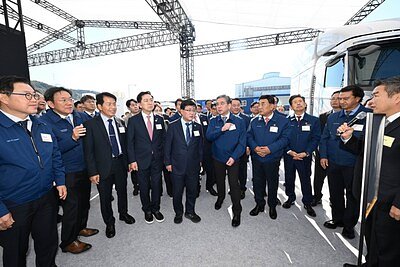
Hyundai's $700M Bet: Fuel Cell Factory Signals Korea's Hydrogen Ambitions
Hyundai’s massive investment in a new hydrogen fuel cell and electrolyzer plant isn't just about cars – it's a strategic push to position South Korea as a global hydrogen leader, challenging the dominance of battery EVs and reshaping the energy landscape.
Hyundai's $700M Bet: Fuel Cell Factory Signals Korea's Hydrogen Ambitions
Ulsan, South Korea – Hyundai Motor Company has broken ground on a KRW 930 billion (approximately $700 million USD) hydrogen fuel cell production facility in Ulsan, South Korea, marking a significant escalation in the global race to establish a hydrogen economy. The plant, slated for completion in 2027, will have the capacity to produce 30,000 fuel cell units and polymer electrolyte membrane (PEM) electrolyzers annually – a unique combination that positions Hyundai as a vertically integrated player in the burgeoning hydrogen market.
Beyond simply expanding production capacity, the facility represents a strategic commitment by Hyundai and the South Korean government to establish the nation as a global leader in hydrogen technology. The groundbreaking ceremony, attended by key government officials and industry leaders, underscores the national importance of this initiative.
A Dual-Track Approach to Hydrogen
The decision to manufacture both fuel cells and electrolyzers under one roof is a key differentiator for Hyundai. Fuel cells convert hydrogen into electricity, powering vehicles and other applications, while electrolyzers use electricity to produce hydrogen from water – effectively creating a closed-loop system. This approach allows Hyundai to control more of the hydrogen value chain and capitalize on both ends of the market.
“This isn't just about building a factory; it’s about building an ecosystem,” explains a senior industry analyst who requested anonymity. “By producing both the means to generate hydrogen and the technology to utilize it, Hyundai is signaling a long-term commitment to hydrogen as a core component of the future energy landscape.”
South Korea's Hydrogen Ambitions
The Ulsan facility is a linchpin in South Korea's broader hydrogen strategy. The government has pledged significant investment in hydrogen infrastructure and is aiming to become a leading exporter of hydrogen technology. The choice of Ulsan as the location for the plant is no accident. The city is already a major industrial hub and is poised to become a central node in South Korea's emerging hydrogen cluster.
“Ulsan has the infrastructure and the skilled workforce to support a thriving hydrogen economy,” says a representative from the city’s economic development agency, speaking on condition of anonymity. “We see this plant as a catalyst for further investment and innovation in the region.”
Challenging the EV Dominance
While battery electric vehicles (BEVs) currently dominate the conversation around sustainable transportation, Hyundai is betting that fuel cell electric vehicles (FCEVs) will play a crucial role in specific applications – particularly for long-haul trucking, buses, and maritime transport.
“BEVs are excellent for passenger vehicles in urban areas, but they face limitations in terms of range and charging time for heavy-duty applications,” explains a materials science researcher specializing in hydrogen technologies. “Fuel cells offer a compelling alternative, with faster refueling times and longer ranges.”
However, FCEVs still face significant hurdles. The cost of fuel cells remains high, and the lack of a widespread hydrogen refueling infrastructure is a major barrier to adoption. A recent market report estimates that the cost of a fuel cell stack remains two to three times higher than a comparable battery pack.
“The biggest challenge is infrastructure,” admits an anonymous source within Hyundai's hydrogen division. “We need to build out a robust network of hydrogen refueling stations to support the widespread adoption of FCEVs. That requires significant investment and collaboration between government and industry.”
A Global Race for Hydrogen Leadership
Hyundai is not alone in its pursuit of a hydrogen-powered future. Companies like Toyota, Nikola, and Ballard Power Systems are also investing heavily in hydrogen technologies. China, Japan, and the European Union are all vying to become leaders in the global hydrogen market.
“There’s a real sense of urgency in the hydrogen space,” says an energy analyst specializing in clean technologies. “Countries and companies are racing to establish a first-mover advantage and capture a share of what is expected to be a multi-trillion dollar market.”
Beyond Transportation: The Promise of Green Hydrogen
The Ulsan facility’s production of PEM electrolyzers is particularly significant. Electrolyzers use renewable electricity to split water into hydrogen and oxygen, creating “green hydrogen” – a clean fuel source that can be used in a wide range of applications, from industrial processes to power generation.
“Green hydrogen has the potential to decarbonize sectors that are difficult to electrify directly, such as steelmaking, cement production, and long-distance shipping,” explains a chemical engineer specializing in hydrogen production.
Hyundai’s vertically integrated approach – combining fuel cell and electrolyzer production – positions the company to capitalize on the growing demand for green hydrogen across multiple industries.
Looking Ahead
The groundbreaking of the Ulsan facility marks a significant step forward in the development of a sustainable hydrogen economy. While challenges remain, Hyundai’s bold investment signals a long-term commitment to hydrogen as a key component of the future energy landscape. The success of this venture will not only depend on technological innovation and cost reduction but also on strong government support and collaboration across the industry. The coming years will be crucial in determining whether hydrogen can truly live up to its promise as a clean, sustainable energy source.
